PAC
The last few decades have seen a significant increase in allergy problems. It is estimated that 12 to 45% of these are probably caused by pollen, whose release, transport and deposition are closely linked to climate conditions. It is to be expected that current climate change will appreciably modify pollen-related allergy problems. The PAC project aims to develop a modelling platform that can be used to simulate the atmospheric concentration of a number of allergenic pollens and correlate them to available clinical data (admissions and consultations for respiratory disorders). This will provide a model that can be used to:
• tackle the long-term impact of climate change on pollen allergies;
• define indices for allergenic risk that can be used as part of a warning system based on short-term weather forecasts.
Objectives
The incidence of allergy-related problems has increased steadily over the last few decades. Between 12 and 45% of these are thought to be attributable to pollen, which is particularly abundant in the atmosphere when plants are in flower. Atmospheric pollen concentrations are closely linked to climate conditions:
• Pollen is released when plants come into flower, the date of which depends on the spring and summer temperatures;
• The quantity of pollen released is proportional to the number of flowers, which in turn depends on the climate conditions over the current and previous year, as well as other factors that influence plant production, such as the atmospheric carbon dioxide concentration.
• The atmospheric pollen concentration depends on meteorological factors (wind and precipitation), which affect how the grains of pollen are carried and deposited.
It is therefore highly likely that the main expected consequences of climate change - temperature rises (and season shifts), changes to precipitation regimes and higher atmospheric CO2 concentrations - will significantly alter the pollination process and the associated allergy problems, and in particular the periods of crisis caused by peak pollen counts.
The aim of the Pollen, Allergy and Climate project (PAC) is to develop a platform for modeling the atmospheric concentrations of a series of allergenic pollens in different climate conditions. The planned platform will attempt to simulate pollen release, transport and depositing. Following this initial stage it will be possible to study the link between the simulated pollen concentrations and their medical impact, based on hospital admission statistics and doctor's appointments for respiratory problems.
Methodology
Part 1: Development of the pollen release model
An occupancy map for the chosen species will be produced with the aid of various tools:
• European tree species maps published by the European Forest Institute (EFI)
• The Flora Europaea database, which contains information on the distribution of plant species
• Regional data concerning certain highly-allergenic species (such as ragweeds)
• A map of French flora, currently being produced by Tela Botanica
A phenological model for estimating periods of pollen release will then be developed from an existing model produced by Isabelle Chuine (A unified model for budburst of trees, Journal of Theoretical Biology, 2000); the new model will be adapted to predict the relative flow of pollen into the atmosphere (Improving prophylaxis for pollen allergies: Predicting the time course of the pollen load of the atmosphere of major allergenic plants in Europe, Grana, 2004). This work will seek to include a new parameter: the quantity of flowers produced each year, which depends on the climate conditions in the present year and the preceding year, and on the concentration of carbon dioxide in the atmosphere.
Part 2: Atmospheric transport
Two existing chemistry/transport models will be reconfigured to include pollen as a new aerosol:
• The CHIMERE model will be used to on the regional scale to determine the correlations with the medical data;
• The INCA model, coupled with the general LMDz circulation model, to study the impact of climate change on pollen transport on a large scale.
In order to quantify the reconfigured models' ability to simulate the observed concentrations and define the related uncertainty, the results of the simulations will be compared with various in situ measurements:
• Measurements obtained via the RNSA's ground sensors
• Aerial measurements in the atmospheric boundary layer, as made by INRA
• Measurements made by LIDAR (an optical instrument capable of measuring particulate pollution) made from the ground and by the satellite CALIPSO.
Part 3: Impact of pollen on health
Pollen causes seemingly benign but sometimes severe disorders that are always inconvenient and in some cases incapacitating:
• Rhinitis with irritation or stinging sensations, sneezing fits, blocked or runny nose;
• Conjunctivitis with watery eyes, itching, redness and an impression of having a foreign body in the eye;
• Coughing, tight chest or wheezing, asthma and shortness of breath;
• Tiredness, headaches, inability to concentrate or short attention span due to sleep being disturbed by rhinitis;
• Skin disorders and an aggravation of certain types of eczema, and more rarely, swelling and rashes.
These symptoms lead some people to consult their doctor or seek emergency care, with the most severe cases requiring hospitalization.
A space-time map of the main pollen-related reasons for medical consultations/hospitalization will be produced based on the available data:
• In the Paris region, Accident & Emergency consultations for health problems caused by pollen can be counted using the data collected in the CERVEAU (CEntre Régional de Veille et d'Action sur les Urgences) system.
• At national level, RNSA operates a national network of sentinel doctors working in around 60 towns and cities, who provide a weekly summary of consultations prompted by pollen-related allergies. The most severe cases - requiring the patient to be hospitalized - are recorded in the PMSI (Programme de Médicalisation des Systèmes d'Information) medical database, which is managed by the Agence Technique de l'Information sur l'Hospitalisation (ATIH).
Based on this map, the project team will attempt to establish a correlation between the reported medical problems and the simulated and measured pollen concentrations.
Part 4: Impact of climate change on allergy risks
Assuming that the previous phases of the study have resulted in the development of a pollen release model that enables realistic simulations to be performed, it will be possible to study the impact of climate change on pollen-related allergy risks. The research team will use two contrasting scenarios for climate change over the 21st century in order to study the variations in pollen concentrations (and hence allergy risks) for several periods (2030, 2050 and 2100). In the course of this research, it may be possible to use the French regionalized climate scenarios developed by the Centre Européen de Recherche et de Formation Avancée en Calcul Scientifique for other projects (i.e. QDiv: Quantifying the effects of global environmental change on terrestrial plant diversity, and VALIDATE: Vulnerability of grassland and livestock farms to climate change and extreme events).
• PREV'AIR: Air quality forecasts and observations in France and elsewhere in Europe
• GDR SIP-GECC: Phenological computer system for management of climate change studies (in French)
• POLLEN: Finnish research project to evaluate and forecast atmospheric concentrations of allergenic pollen in Europe
• Météo-France file: Climate change and allergies (in French)
• Presentation by Michel Thibaudon, director of the RNSA (French national aerobiological monitoring network), on the topic of "Meteorology and Pollenosis" (in French)
Phenology: Study of the timing of recurrent events in animal and plant life, in relation to the climate, for example, plant flowering, leaf colouring in autumn, the arrival of migratory birds, etc.
| Climate, aerosols | Nicolas VIOVY Directeur de recherche CEA au LSCE Nicolas.Viovy @ lsce.ipsl.fr |
| Health Sciences |
Bertran Auvert UFR de Médecine, UVSQ Bertran.Auvert @ uvsq.fr |







